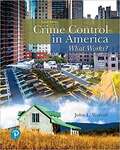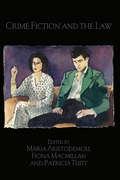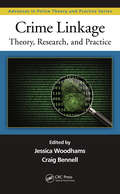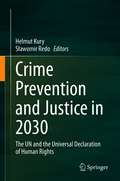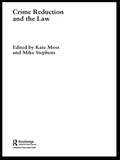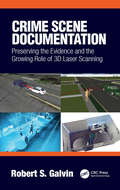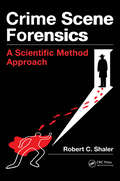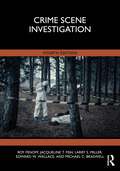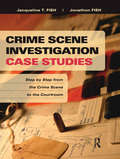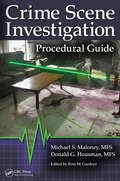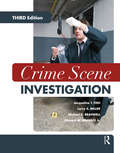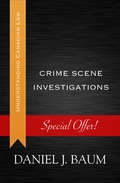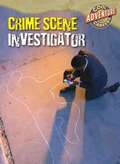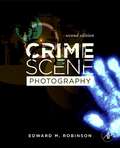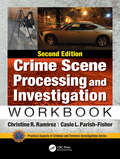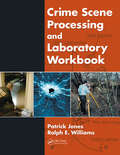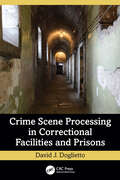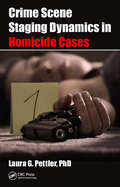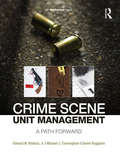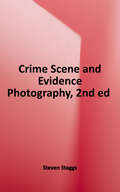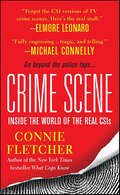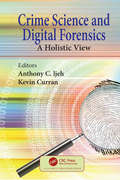- Table View
- List View
Crime Control in America: What Works? (What's New in Criminal Justice)
by John WorrallFor courses in crime prevention, introduction to criminal justice, and criminal justice policy. <p><p> Crime Control in America: What Works? provides comprehensive coverage of what works in policing, prosecution, courts, and legislative methods of crime control. It also moves beyond the justice system and examines the effectiveness of crime control at the individual, family, school, and community levels. Finally, it covers environmental criminology and explanations of large-scale crime trends. <p><p> The 4th edition includes new sections covering the most current and controversial topics in crime control, including the alleged Ferguson effect, immigration enforcement, raising the age of majority, and mass shootings.
Crime Fiction and the Law (Birkbeck Law Press)
by Maria Aristodemou Fiona Macmillan Patricia TuittThis book opens up a range of important perspectives on law and violence by considering the ways in which their relationship is formulated in literature, television and film. Employing critical legal theory to address the relationship between crime fiction, law and justice, it considers a range of topics, including: the relationship between crime fiction, legal reasoning and critique; questions surrounding the relationship between law and justice; gender issues; the legal, political and social impacts of fictional representations of crime and justice; post-colonial perspectives on crime fiction; as well as the impact of law itself on the crime fiction’s development. Introducing a new sub-field of legal and literary research, this book will be of enormous interest to scholars in critical, cultural and socio-legal studies, as well as to others in criminology, as well as in literature.
Crime Linkage: Theory, Research, and Practice (Advances in Police Theory and Practice)
by Jessica Woodhams Craig BennellThe increasing portrayal of forensic investigative techniques in the popular media CSI, for example, has resulted in criminals becoming "forensically aware" and more careful about leaving behind physical evidence at a crime scene. This presents law enforcement with a significant problem: how can they detect serial offenders if they cannot rely on p
Crime Prevention and Justice in 2030: The UN and the Universal Declaration of Human Rights
by Helmut Kury Sławomir RedoThis book analyzes human rights and crime prevention challenges from the perspective of the 1948 Universal Declaration of Human Rights and the 2030 United Nations Sustainable Development Agenda, in particular its goal 16 on promoting peaceful, inclusive and just societies, the creation and development of which depend on the interplay between various secular and non-secular (f)actors. The book reflects on the implementation of these two legal instruments from a “back to the future” standpoint, that is, drawing on the wisdom of contributors to the 2030 Agenda from the past and present in order to offer a constructive inter-disciplinary and intergenerational approach. The book’s intended readership includes academics and educationists, criminal justice practitioners and experts, diplomats, spiritual leaders and non-governmental actors; its goal is to encourage them to pursue a socially and human rights oriented drive for “larger freedom,” which is currently jeopardized by adverse political currents.
Crime Prevention, Migration Control and Surveillance Practices: Welfare Bureaucracy as Mobility Deterrent
by Veronika NagyEU expansion has stoked fears that criminals from the East may abuse freedom of movement to exploit the benefit systems of richer states. This book examines the way in which physical state borders are increasingly being replaced by internal border controls in the form of state bureaucracies as a means of regulating westward migration. The work examines the postmodern effect of globalisation and how ontological anxieties contribute to securitisation and social sorting in Western countries. It discusses the changes in control societies and how targeted surveillance as a geopolitical tool leads to new digitalised mechanisms of population selection. The book presents a casestudy of Roma migrants in the UK to examine the coping strategies adopted by those targeted. The book also critically evaluates the limitations of digitalised bureaucratic systems and the dangers of reliance on virtual data and selection methods.
Crime Prevention: International Perspectives, Issues, and Trends
by John A. WinterdykThis text presents an international approach to the study of crime prevention. It offers an expansive overview of crime prevention initiatives and how they are applied across a wide range of themes and infractions, from conventional to non-conventional forms of crime. Based on a review of the literature, this is the first text to offer a broad, yet comprehensive, examination of how and why crime prevention has gained considerable traction as an alternative to conventional criminal justice practices of crime control in developed countries, and to provide a cross-sectional view of how crime prevention has been applied and how effective such initiatives have been. Crime Prevention: International Perspectives, Issues, and Trends is suitable for undergraduate students in criminology and criminal justice programs, as well as for graduates and undergraduates in special topics courses.
Crime Prevention: Theory and Practice, Second Edition
by Stephen SchneiderIn Crime Prevention: Theory and Practice, Second Edition, Dr. Schneider has updated every chapter in this reliable text using the latest research, the most recently published articles and books, and feedback from professors and students using the first edition. Providing an introduction to dominant approaches, key concepts, theories, and research,
Crime Reduction and the Law
by Kate Moss Mike StephensThis innovative and pioneering new book establishes links between crime reduction and the law, uniquely offering a detailed examination of how specific legislation and performance targets aid or undermine attempts at crime reduction. Providing a sustained analysis, this ground-breaking book considers the social policy, politics and legislation that surround and drive the crime reduction agenda. It analyzes: the creation of 'safe environments' through Town and Country Planning legislation the role of local authorities in crime reduction initiatives the nature of drug policy, paedophilia legislation and programs to control mental disorder crime. Bringing together the work of internationally renowned experts in this field, this book will prove very useful to students of criminology and sociology, as well as crime prevention and reduction practitioners, police officers and community safety partnership professionals.
Crime Scene Documentation: Preserving the Evidence and the Growing Role of 3D Laser Scanning
by Robert S GalvinWhen a criminal act or vehicle crash occurs, most often a local law enforcement agency responds and is responsible for both investigating the scene and for documenting it. It is critical that scene evidence is collected and recorded efficiently, as the scene can quickly change. The sooner evidence can be collected, reviewed, and analyzed, the better an understanding investigators will have as to how and why the incident occurred. Crime Scene Documentation: Preserving the evidence and the growing role of 3D laser scanning demonstrates at length the value of laser scanning through the use of numerous case studies of investigators who have utilized various 3D technologies and laser scanning to document scenes. Thorough and accurate scene documentation is an essential function at a science and proves particularly valuable in courtroom presentations to help jurors understand a crime or accident’s likely chain of events. The more advanced a scene documentation method is, the better it can be utilized to capture details that will lead to optimal scene diagramming. Currently, 3D laser scanning is the most advanced method of scene documentation available, capturing detailed and realistic digital scans—capturing scenes in their entirety—and yielding a permanent representation of the scene for study and analysis at any time, even years after a crime scene has vanished. The book explains current technology, the latest advances, and how to best utilize the technology. Case examples come from various applications, from tools to programs, can help crash scene investigators understand how scanning can improve scene documentation, provide better and more evidence details, and build more credible diagrams that possibly may be used in court presentations to help support a case. Key Features: Describes 3Dscene recording methods in use and how well they work Outlines the variables and inherent challenges associated with documenting crime and crash scenes Illustrates the positive, and dramatic, impact of having a well-documented scene, particularly in the courtroom Explores how 3D laser scanning has vastly changed the way and extent to which crime and crash scenes can be captured accurately and completely, and subsequently analyzed Explains how laser scanning is highly flexible and presents strategies to integrate it into other crime scene incident recording techniques and technologies Crime Scene Documentation details the many benefits of 3D laser scanning technology relative to its reliability and accuracy as well as the multiple case scenarios in which it can be used. The book serves as an invaluable resource to crime scene technicians, investigators, and reconstructionists on the best ways to document a crime or crash scene.
Crime Scene Forensics: A Scientific Method Approach
by Robert C ShalerBridging the gap between practical crime scene investigation and scientific theory, Crime Scene Forensics: A Scientific Method Approach maintains that crime scene investigations are intensely intellectual exercises that marry scientific and investigative processes. Success in this field requires experience, creative thinking, logic, and the correct
Crime Scene Investigation
by Larry S. Miller Michael C. Braswell Jacqueline T. Fish Edward W. Wallace Roy FenoffCrime Scene Investigation offers an innovative approach to learning about crime scene investigation, taking the reader from the first response on the crime scene to documenting crime scene evidence and preparing evidence for courtroom presentation. It includes topics not normally covered in other texts, such as forensic anthropology and pathology, entomology, arson and explosives, and the electronic crime scene. Numerous photographs and illustrations complement text material, and a chapter-by-chapter fictional narrative also provides the reader with a qualitative dimension of the crime scene experience.
Crime Scene Investigation Case Studies: Step by Step from the Crime Scene to the Courtroom
by Jacqueline T. Fish Jonathon FishThis text offers an innovative approach to learning about crime scene investigation, taking the reader from the first response on the crime scene to documenting crime scene evidence and preparing evidence for courtroom presentation. It includes topics not normally covered in other texts, such as forensic anthropology and pathology, arson and explosives, and the electronic crime scene. Numerous photographs and illustrations complement text material. A chapter-by-chapter fictional narrative also provides the reader with a qualitative dimension of the crime scene experience. Crime Scene Investigation is further enhanced by the contributions of such recognized forensic scholars as William Bass and Arthur Bohannon.
Crime Scene Investigation Procedural Guide
by Ross M. Gardner Michael S. Maloney Donald HousmanThose tasked with investigating crime scenes come from a variety of backgrounds and varying levels of experience. Crime Scene Investigation Procedural Guide gives the novice investigator the procedures for almost any crime scene imaginable while providing the seasoned pro a ready reference for crimes occurring even under the most unusual of circums
Crime Scene Investigation: Step By Step From The Crime Scene To The Courtroom
by Larry S. Miller Michael C. Braswell Jacqueline T. Fish Edward W. WallaceCrime Scene Investigation offers an innovative approach to learning about crime scene investigation, taking the reader from the first response on the crime scene to documenting crime scene evidence and preparing evidence for courtroom presentation. It includes topics not normally covered in other texts, such as forensic anthropology and pathology, arson and explosives, and the electronic crime scene. Numerous photographs and illustrations complement text material, and a chapter-by-chapter fictional narrative also provides the reader with a qualitative dimension of the crime scene experience.
Crime Scene Investigations
by Daniel J. BaumWhen police are called in to investigate a crime, what powers and limitations apply to them? What are their rights to question strangers, search without warrants, or detain individuals who might become suspects? Crime Scene Investigations breaks down the Supreme Court's decisions on questions like these into clear and practical terms. Police need to be vigilant, since the line between a lawful search and an improper one can be dangerously thin, and officers can be held accountable for any wrongdoing, intentional or not. The controversy surrounding such techniques as "stop-and-frisk" sweeps and compulsory DNA testing underscores the importance of understanding the legal dimensions of police powers. Because interactions between law enforcement officers and civilians are often charged with complexities, Crime Scene Investigations provides a level-headed guide, indispensable for those on either side of an investigation.
Crime Scene Investigator (Cool Adventure Careers)
by Geoffrey M. HornThe first group of titles in an ongoing series introduces students to six amazing adventure careers. Geared for reluctant readers in upper elementary school and above, each high-interest title combines easy-to-follow text with engaging on-the-job photos to spark students' interest in reading and career exploration. Each book is filled with descriptive information about the career, along with the skills and requirements needed to pursue a job in the profiled field.
Crime Scene Photography (Second Edition)
by Edward M. RobinsonCrime Scene Photography, Second Edition covers the general principals and concepts of photography, while also delving into the more practical elements and advanced concepts of forensic photography. Edward Robinson assists the reader in understanding and applying essential concepts in order to create images that are able to withstand challenges in court. The first part of the book deals with the basic theory and science of photography required to take superior photographs, and covers topics such as composition, exposure, focus, depth of field, and flash techniques. The second part of the text deals specifically with the challenges of photographing a crime scene, including instructions on how to document bodies and wounds, traffic accident photography, underwater photography and aerial photography. In the latter portions of the text, the author turns to digital theory and its advantages and disadvantages. * Over 600 full color photographs, also electronically available on the companion website * Two new chapters on 'The History of Forensic Photography,' and 'Digital Image Processing of Evidentiary Photography' * Includes an Instructor website with lecture slides, practical exercises, a test bank and image collection * An essential reference for crime scene photography, including topics such as Composition, the Inverse Square Law, Court Cases affecting photography, Digital Image Processing, and Photogrammetry * Required reading by the Crime Scene Certification Board of the International Association for Identification (IAI) for all levels of certification
Crime Scene Processing and Investigation Workbook, Second Edition
by Christine R. Ramirez Casie L. Parish-FisherCrime Scene Processing and Investigation Workbook, Second Edition is the only workbook which directly supports and cross-references methodology and terminology presented in Ross Gardner and Donna Krouskup’s perennial best-seller Practical Crime Scene Processing and Investigations, Third Edition. The workbook serves as supporting material offering hands-on activities to supplement theories and methodologies within the text as well as updated activities to support the new material presented in the Third Edition. As the number of forensic academic programs within the United States continue to grow—and the textbook continues to be a go-to standard in the field—the workbook remains an invaluable reference for academics, forensic training providers, and law enforcement training programs. The detailed Instructor’s Manual (IM) lends itself not only to experts who have utilized these procedures before but also to the novice and student who may be introduced to these topics in a classroom setting for the first time. The workbook conducts over 30 activities with detailed instructions, concept overviews, and reflective post-lab questions. Crime Scene Processing and Investigation Workbook, Second Edition, continues to stand as the best workbook on the market, addressing foundational principles in a hands-on manner while directly correlating to the concepts addressed in the Gardner and Krouskup textbook.
Crime Scene Processing and Laboratory Workbook
by Patrick Jones Ralph E. WilliamsThe most important part of a CSI‘s (crime scene investigator) job is accurate documentation of properly collected evidence. Documentation tells the story of the crime and can ultimately prove a suspect guilty. Through an array of specific exercises and actual document templates used in practice, Crime Scene Processing and Laboratory Workbook teache
Crime Scene Processing in Correctional Facilities and Prisons
by David J. DogliettoCrime scenes within correctional facilities present investigators with myriad challenges, not only in working, investigating, and collecting evidence but also in obtaining reliable eyewitness accounts. As a result, they are some of the most challenging cases and environments that any investigator will encounter.Crime Scene Processing in Correctional Facilities and Prisons addresses the unique challenges in prison, correction, and detention facilities, outlining specific procedures and techniques that will reliably improve any investigation. Issues of contaminated crime scenes can result from guards trying to regain order, few to no dedicated staff with no training or understanding of crime scenes, a lack of cooperation from witnesses and victims, and even the lack of cooperation from the on-scene incident commander – whose main objective may be to return the facility to “normal” rather than allow for the proper collection of evidence. Whatever the challenges faced, this book tackles all of them. While the processing of crime scenes entails standard procedures and practices, a correctional setting can provide anything but. As a result, the investigator must be resourceful, tenacious – yet patient – and perform their duties with objectivity and ethical integrity throughout the process.Features: Serves as the only resource on the market to provide essential investigative and crime scene guidelines unique and specific to correctional facilities Presents the various challenges of gathering and preserving evidence and investigating crimes, in correctional settings – including federal and state prisons, jails, and detention facilities In addition to presenting best practices in handling evidence and investigative procedures, covers unique interview techniques, report writing, and expert testimony Author David Doglietto, as an experienced professional with decades of first-hand experience, walks readers through the best way to perform duties to cut through the challenges and barriers and avoid the pitfalls that come with the oftentimes complex investigations in these environments. Extensive illustrations and case examples are provided within the book, as chapters present best-practice investigative practices in an environment for which there is little published resource and reference material. Crime Scene Processing in Correctional Facilities and Prisons is an invaluable resource for crime scene investigators, legal professionals, and the staff, leadership, and managers of correctional facilities themselves.
Crime Scene Staging Dynamics in Homicide Cases
by Laura Gail PettlerIndividuals who perpetrate murder sometimes pose or reposition victims, weapons, and evidence to make it look like events happened in a different way than what actually transpired. Until now, there has been scarce literature published on crime scene staging.Crime Scene Staging Dynamics in Homicide Cases is the first book to look at this practice, p
Crime Scene Unit Management: A Path Forward
by Edward W. Wallace Michael J. Cunningham Daniel BoggianoCrime Scene Unit Management: A Path Forward is a must-have resource for anyone involved with forensic investigations and the search for evidence at the crime scene. The book provides standards for how to manage a crime scene so that evidence is collected and preserved without errors and includes guidelines for how to implement the standards and set up regional training programs for smaller jurisdictions with tighter budgets. Key features include examples, checklists, and flow charts for evidence handling and routing. CSIs, fire investigators, homicide investigators, accident investigators, police executives, and students of forensic science will benefit from this thorough approach to how the crime scene—and the personnel charged with tending to the evidence—should be managed.
Crime Scene and Evidence Photography
by Steven StaggsThis book is designed for those responsible for photography at the crime scene and in the laboratory. It may be used by law enforcement officers, investigators, crime scene technicians, and forensic scientists. It contains instructions for photographing a variety of crime scenes and various types of evidence. It is a valuable reference tool when combined with training and experience. Crime Scene and Evidence Photography is also a helpful resource for students and others interested in entering into the field of crime scene investigation.
Crime Scene: Inside the World of the Real CSIs
by Connie FletcherMost people who work as actual crime scene investigators will tell you two things: Television doesn't always show the truth...and science never lies. But how do DNA experts, trace analysts, medical examiners, forensic pathologists, and cold case detectives work together to produce evidence and solve a case—beyond the shadow of a doubt? In this fascinating, true-life account, America's leading crime experts share their personal, unforgettable stories. From powder burn to fiber analysis, blood spatter to skeletal remains, New York Times bestselling author Connie Fletcher takes you into a world of crime-solving that's even grittier, more bizarre, and more shocking than any TV show. It's a thrilling ride into the dead center of a crime scene.
Crime Science and Digital Forensics: A Holistic View
by Anthony C. IjehThis volume is a collation of articles on counter forensics practices and digital investigative methods from the perspective of crime science. The book also shares alternative dialogue on information security techniques used to protect data from unauthorised access and manipulation. Scandals such as those at OPCW and Gatwick Airport have reinforced the importance of crime science and the need to take proactive measures rather than a wait and see approach currently used by many organisations. This book proposes a new approach in dealing with cybercrime and unsociable behavior involving remote technologies using a combination of evidence-based disciplines in order to enhance cybersecurity and authorised controls. It starts by providing a rationale for combining selected disciplines to enhance cybersecurity by discussing relevant theories and highlighting the features that strengthen privacy when mixed. The essence of a holistic model is brought about by the challenge facing digital forensic professionals within environments where tested investigative practices are unable to provide satisfactory evidence and security. This book will be of interest to students, digital forensic and cyber security practitioners and policy makers. It marks a new route in the study of combined disciplines to tackle cybercrime using digital investigations and crime science.
